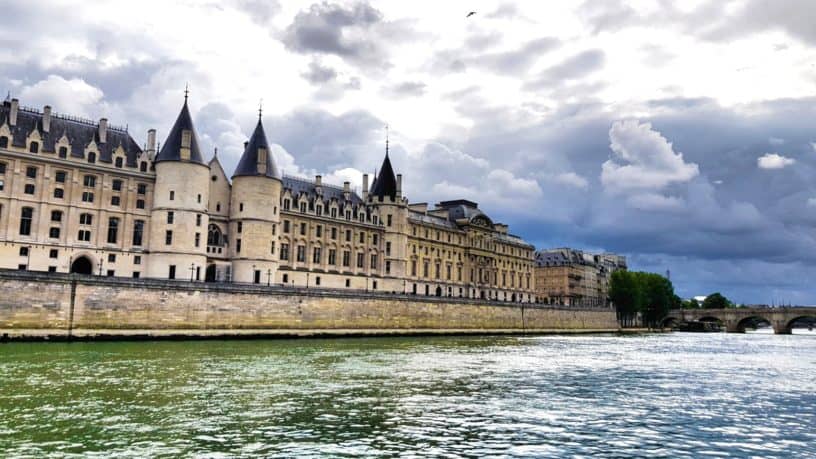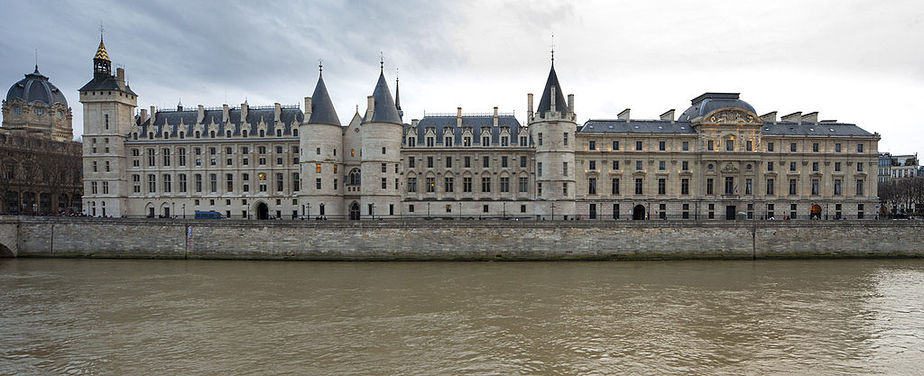A visit to La Conciergerie
On the Ile de la Cité, in the center of Paris, most people know the gothic Notre-Dame Cathedral. Those who already visited it, however, know that there is another quite impressive monument nearby. With its four massive and distinguishable towers, La Conciergerie, seems like a castle floating on the Seine.
Here is a guide to this lesser known historical jewel.
What is La Conciergerie exactly?
La Conciergerie is technically the northernmost part of a large complex of buildings on the Ile de la Cité: Le Palais de la Cité (the City Palace). The latter served as the main residence for the Kings of France between the 6th and the 14th centuries. After the Royals left it, the Palace kept administrative functions and a prison was added to it. During this period, the management of the Palace and the urgent matters were to be handled by a man appointed by the king in case he was absent and who was called “Le Concierge”, which gave the place its name. After the prison opened, the Concierge had a crucial role in keeping the prisoners locked. The name “Conciergerie” now commonly refers to this prison.
What is the history of the City Palace?
Originally built over the remains of the Roman palace – this part of the Island always served as a center of power – the first small palace of Merovingian kings was turned into a grandiose castle by the Capetian dynasty successive kings. Philip Augustus, Louis IX and Philip IV were those who most notably transformed it into a sumptuous residence.

The City Palace in 1410 – Miniature by the Limbourg Brothers in Les Très Riches Heures du Duc de Berry (Public Domain)
Louis IX for instance added a magnificent chapel to it, in order to protect the Holy Crown of Thornes and other relics brought back from his Crusades. This chapel is now known as Sainte Chapelle and is well worth the visit – and it is also worth an article of its own.
In the mid-14th century, Charles V left the Palace to settle in the Louvre on the other side of the River. The Kings were never to return and live in the City Palace again. However, most administrative function remained there, especially the actions of Justice and the Royal Treasure. The large halls of the street level were turned into a jail.
The jails of La Conciergerie operated almost continuously since then. The penitentiary function of the building only ended in the early 20th century! The Revolutionary period, however, is clearly the one that mostly marked the history of the prison, since more than 2500 prisoners were sentenced to death here, in less than two years. Marie Antoinette, Danton or Robespierre were some of the most famous prisoners.
The rest of the Palace became the Palace of Justice. A newer modern Palace of Justice was built in the North-West of Paris and opened in 2018. However, the City Palace continues serving as a complement to the new Palace of Justice.
What will I see?
First and foremost, take the time to look at the building before entering it. On the Seine side, four massive towers dominate the river. To the extreme right (looking from the Seine), the Tour Bombec is the oldest tower. It was built under Louis IX and is the only one with battlements. Its name derives from the French expression “bon bec” (which colloquially means “good mouth”) since it was in this tower that prisoners were being tortured in order to talk. The twin towers in the middle were the Tour César and the Tour d’Argent which respectively contained jails and parts of the Royal Treasure. At last, the tower to the left is the Clock Tower. You may admire the large and marvelous public clock at the top. This is the oldest public clock in Paris, dating back from the 16th century (although a clock was installed on the tower as early as in the 14th century).
When you enter the building, you arrive into the Armed People Room, a beautiful gothic vaulted room which served as a large common room and refectory for the king’s personnel. It was once right below the Capetian’s Great Hall (now disappeared). To the right, you may see the kitchen whose food was directly brought in by boat from the Seine. At the end of this section, the Guards’ Room was an antechamber to climb into the disappeared Great Hall, above.
Then, you leave behind those 14th century remains and enter the Revolutionary section of the building. You first take “Paris Street”, a long elevated section which led to the jails and that bears its name from “Monsieur de Paris”, the nickname of the executioner.
Upon entering the prison, you see a corridor, the “Prisoners’ corridor”, lined with three small offices. The Registrar was in charge of registering the prisoners, the Concierge was the director of the prison – as I explained previously – and the last room is the “Washing Room” which was in fact the place where prisoners had their hair cut before their beheading…
You see also some typical cells from this period of time. Most cells you see are of the better kind – that is reserved for noble prisoners. Bourgeois where locked in less agreeable rooms known as “cell of the Pistole” for which they had to pay for quite expensive fees. At last, commoners who couldn’t afford the Pistole where all gathered in shared cells with hay on the floor – known as cell of the “Pailleux”. These last rooms where prone to diseases. The building also had some oubliettes and dungeons, to throw away disturbing prisoners and let them be forgotten.
On the first floor, in a small room, are listed all the names of the prisoners who ever spent some time in La Conciergerie. Digital systems help you learn more about each of them, if you wish to.
At last, throughout the visit, thematic rooms help you better understand how La Conciergerie worked and how it became a major place in French History.
The visit ends by a walk in the Ladies Courtyard, a small enclosed courtyard where women were allowed a short walk during the day.
Practical Information
Acces – To come to La Conciergerie, I advise you stop at Châtelet Station and walk across the Seine on Pont du Change. The closest Metro station is Cité (line 4) but you will arrive to the building from a less interesting side. By arriving via Châtelet and Pont du Change you give yourself the best views onto the side towers and the medieval architecture of the building.
Opening Hours – La Conciergerie is open every day from 9.30 AM to 6.00PM (booths close at 5.30PM)
Entrance Fee and Extra –
- If you are a Paris Museum Pass holder, you can access La Conciergerie directly.
- Likewise, if you are under 18 years old (and even under 25 AND a citizen of the EU), if you are a French unemployed person, or if you are a disabled person, you may access La Conciergerie for free.
- If you are between 18 and 25 years of age, AND NOT a citizen of the European Union, your ticket costs 7€
- If you are not in the previous cases, your ticket costs 9€.
- You may purchase a dual ticket giving you access to both La Conciergerie and Sainte Chapelle, which costs 15€
- You may ask for a “histopad” in addition to you entrance fee for 5€.
Visits – One-hour guided tours are available. You don’t need to book in advance, however, you may inquire the tour times by calling (+33) 1 53 73 78 58 on the day of your visit.
Should I visit it?
I will be honest with you. Although the history of the building and the architecture are great, the tourist information and layout could be improved.
If you have no interest in history, the visit of La Conciergerie is definitely something you should avoid. The tour is quite short since only a few cells and the main halls are opened to the public, and the rooms are mostly empty shells, well reflecting medieval architecture, but surely quite boring if you don’t really care about what happened there. You do not need to buy a ticket to La Conciergerie to visit the next-door Sainte Chapelle – which you should however absolutely visit. So, I would recommend you only visit La Conciergerie if you want to see a historic site, and inform yourself on what happened in these walls.
The visit can be done with or without a guide. On your own, the tour can be completed in an hour/an hour and a half. I highly recommend you take a guided tour. Let’s face it, the one thing you’ll want, there, is information. The paper document for a self-guided tour is quite basic and the “histopad” app which aims at replacing a simple audioguide is not very practical, and just as basic, in my opinion.
Conclusion
La Conciergerie is a place to see, but to enjoy your visit you need to appreciate history and take the time to understand it. Like a cold vessel on the river Seine, La Conciergerie is a great complement to a larger visit in the historical core of Paris, the Ile de la Cité. For a perfect day back in time, I recommend you visit La Conciergerie along with Sainte Chapelle and that you consider taking our 75-minute free guided tour around Notre Dame area, to perfectly cover the main landmarks of Paris most intriguing island…
Planning a trip to Paris ? Get ready !
These are Amazon’s best-selling travel products that you may need for coming to Paris.
Bookstore
- The best travel book : Rick Steves – Paris 2023 – Learn more here
- Fodor’s Paris 2024 – Learn more here
Travel Gear
- Venture Pal Lightweight Backpack – Learn more here
- Samsonite Winfield 2 28″ Luggage – Learn more here
- Swig Savvy’s Stainless Steel Insulated Water Bottle – Learn more here
Check Amazon’s best-seller list for the most popular travel accessories. We sometimes read this list just to find out what new travel products people are buying.














